COM201 Essay: Ludification of Culture and Everyday Practices
VerifiedAdded on 2023/01/19
|7
|2080
|93
Essay
AI Summary
This essay critically examines the ludification of culture, arguing that it functions as a marketing strategy influencing everyday life practices. It defines key concepts like gamification and playbor, explaining how game elements are used to engage individuals in various activities, often for business profit. The essay explores the rise of digital spaces and their impact on behavior, highlighting the increasing presence of games and the shift in how people spend their time. It also discusses different perspectives on gamification, including Ian Bogost's critique, and the role of play in labor. The essay references scholarly works to support its arguments and concludes that ludification has significantly transformed modern practices. The essay analyzes the impact of ludification on contemporary culture and how it has become a strategic concept to understand the changes in contemporary culture.
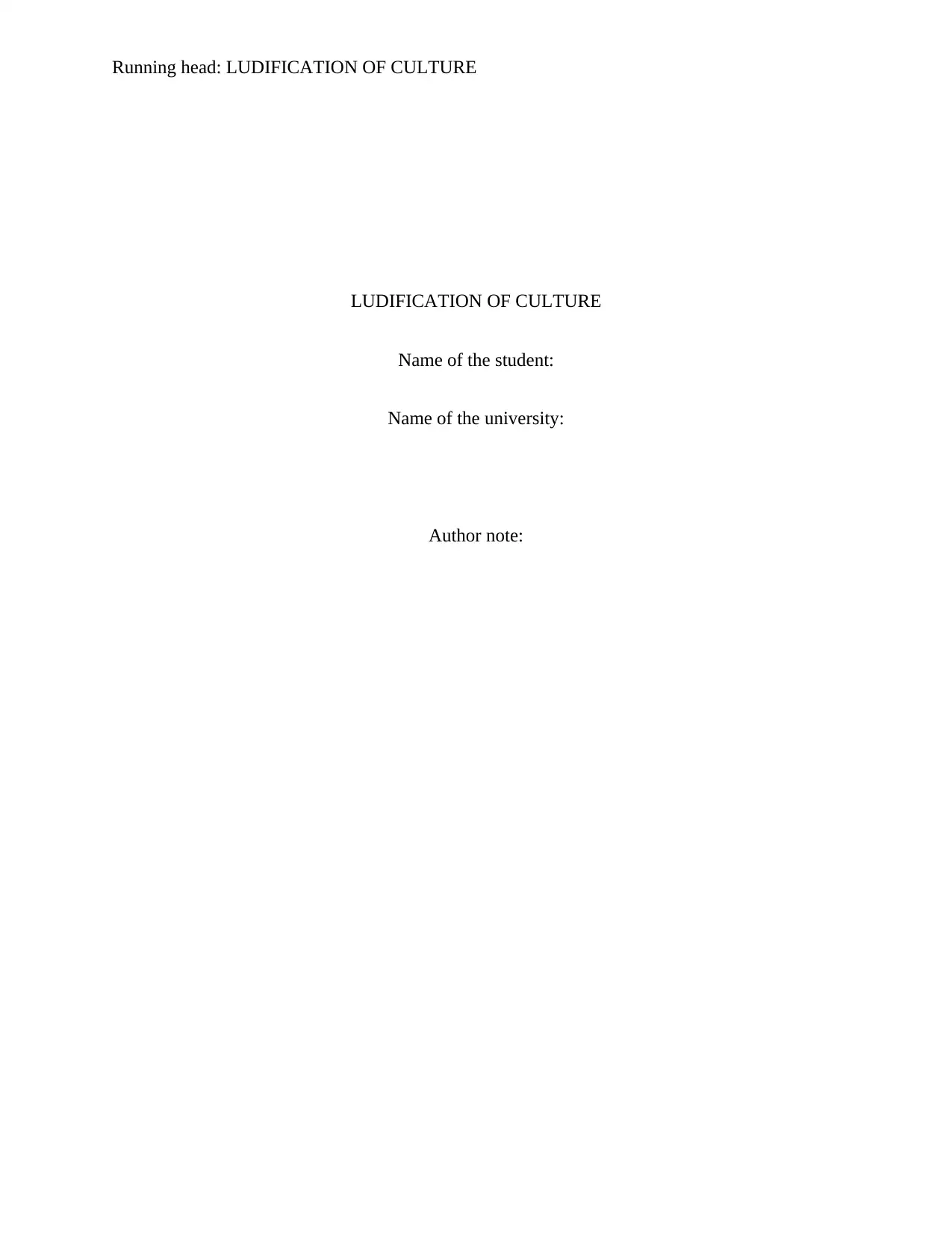
Running head: LUDIFICATION OF CULTURE
LUDIFICATION OF CULTURE
Name of the student:
Name of the university:
Author note:
LUDIFICATION OF CULTURE
Name of the student:
Name of the university:
Author note:
Paraphrase This Document
Need a fresh take? Get an instant paraphrase of this document with our AI Paraphraser
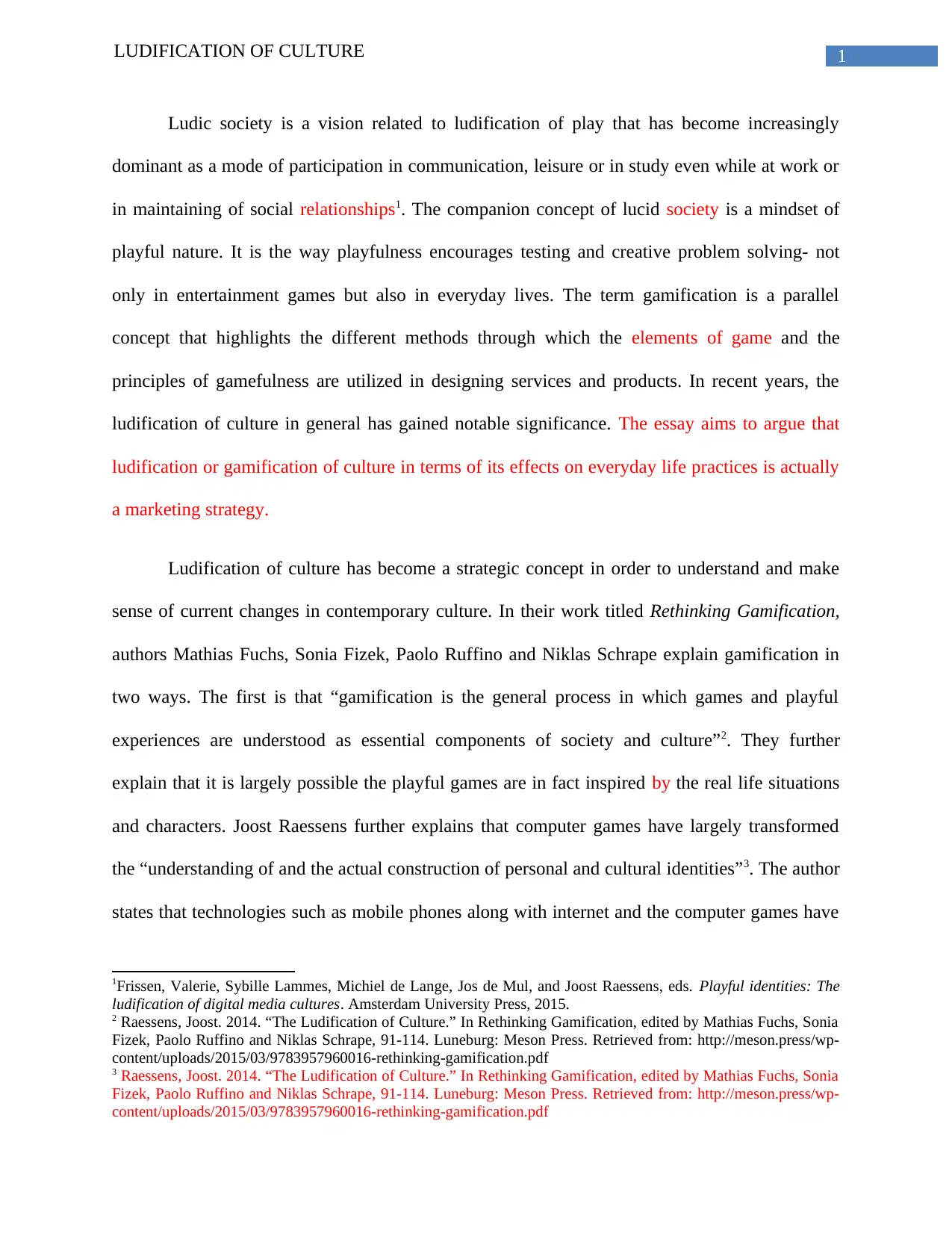
1LUDIFICATION OF CULTURE
Ludic society is a vision related to ludification of play that has become increasingly
dominant as a mode of participation in communication, leisure or in study even while at work or
in maintaining of social relationships1. The companion concept of lucid society is a mindset of
playful nature. It is the way playfulness encourages testing and creative problem solving- not
only in entertainment games but also in everyday lives. The term gamification is a parallel
concept that highlights the different methods through which the elements of game and the
principles of gamefulness are utilized in designing services and products. In recent years, the
ludification of culture in general has gained notable significance. The essay aims to argue that
ludification or gamification of culture in terms of its effects on everyday life practices is actually
a marketing strategy.
Ludification of culture has become a strategic concept in order to understand and make
sense of current changes in contemporary culture. In their work titled Rethinking Gamification,
authors Mathias Fuchs, Sonia Fizek, Paolo Ruffino and Niklas Schrape explain gamification in
two ways. The first is that “gamification is the general process in which games and playful
experiences are understood as essential components of society and culture”2. They further
explain that it is largely possible the playful games are in fact inspired by the real life situations
and characters. Joost Raessens further explains that computer games have largely transformed
the “understanding of and the actual construction of personal and cultural identities”3. The author
states that technologies such as mobile phones along with internet and the computer games have
1Frissen, Valerie, Sybille Lammes, Michiel de Lange, Jos de Mul, and Joost Raessens, eds. Playful identities: The
ludification of digital media cultures. Amsterdam University Press, 2015.
2 Raessens, Joost. 2014. “The Ludification of Culture.” In Rethinking Gamification, edited by Mathias Fuchs, Sonia
Fizek, Paolo Ruffino and Niklas Schrape, 91-114. Luneburg: Meson Press. Retrieved from: http://meson.press/wp-
content/uploads/2015/03/9783957960016-rethinking-gamification.pdf
3 Raessens, Joost. 2014. “The Ludification of Culture.” In Rethinking Gamification, edited by Mathias Fuchs, Sonia
Fizek, Paolo Ruffino and Niklas Schrape, 91-114. Luneburg: Meson Press. Retrieved from: http://meson.press/wp-
content/uploads/2015/03/9783957960016-rethinking-gamification.pdf
Ludic society is a vision related to ludification of play that has become increasingly
dominant as a mode of participation in communication, leisure or in study even while at work or
in maintaining of social relationships1. The companion concept of lucid society is a mindset of
playful nature. It is the way playfulness encourages testing and creative problem solving- not
only in entertainment games but also in everyday lives. The term gamification is a parallel
concept that highlights the different methods through which the elements of game and the
principles of gamefulness are utilized in designing services and products. In recent years, the
ludification of culture in general has gained notable significance. The essay aims to argue that
ludification or gamification of culture in terms of its effects on everyday life practices is actually
a marketing strategy.
Ludification of culture has become a strategic concept in order to understand and make
sense of current changes in contemporary culture. In their work titled Rethinking Gamification,
authors Mathias Fuchs, Sonia Fizek, Paolo Ruffino and Niklas Schrape explain gamification in
two ways. The first is that “gamification is the general process in which games and playful
experiences are understood as essential components of society and culture”2. They further
explain that it is largely possible the playful games are in fact inspired by the real life situations
and characters. Joost Raessens further explains that computer games have largely transformed
the “understanding of and the actual construction of personal and cultural identities”3. The author
states that technologies such as mobile phones along with internet and the computer games have
1Frissen, Valerie, Sybille Lammes, Michiel de Lange, Jos de Mul, and Joost Raessens, eds. Playful identities: The
ludification of digital media cultures. Amsterdam University Press, 2015.
2 Raessens, Joost. 2014. “The Ludification of Culture.” In Rethinking Gamification, edited by Mathias Fuchs, Sonia
Fizek, Paolo Ruffino and Niklas Schrape, 91-114. Luneburg: Meson Press. Retrieved from: http://meson.press/wp-
content/uploads/2015/03/9783957960016-rethinking-gamification.pdf
3 Raessens, Joost. 2014. “The Ludification of Culture.” In Rethinking Gamification, edited by Mathias Fuchs, Sonia
Fizek, Paolo Ruffino and Niklas Schrape, 91-114. Luneburg: Meson Press. Retrieved from: http://meson.press/wp-
content/uploads/2015/03/9783957960016-rethinking-gamification.pdf
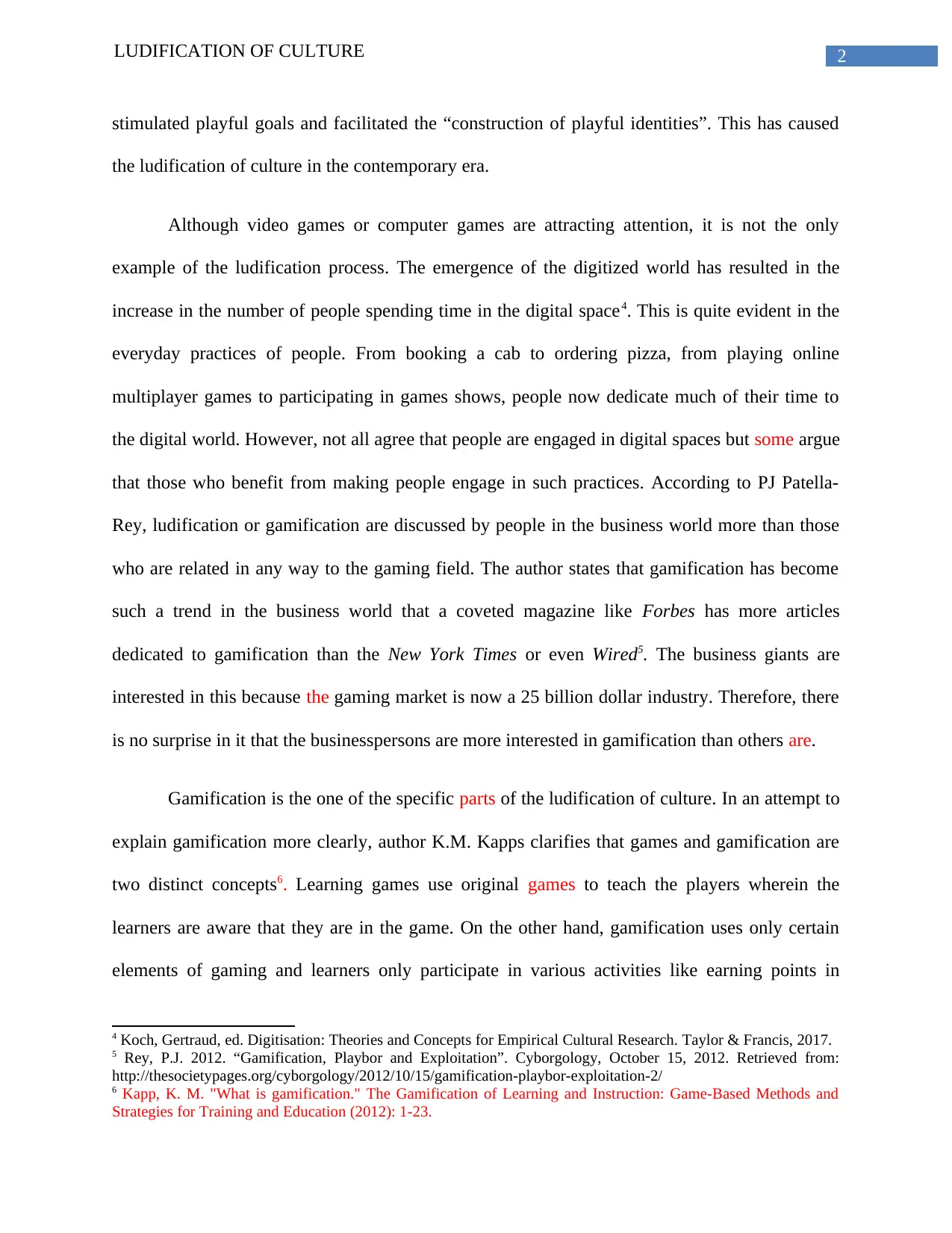
2LUDIFICATION OF CULTURE
stimulated playful goals and facilitated the “construction of playful identities”. This has caused
the ludification of culture in the contemporary era.
Although video games or computer games are attracting attention, it is not the only
example of the ludification process. The emergence of the digitized world has resulted in the
increase in the number of people spending time in the digital space4. This is quite evident in the
everyday practices of people. From booking a cab to ordering pizza, from playing online
multiplayer games to participating in games shows, people now dedicate much of their time to
the digital world. However, not all agree that people are engaged in digital spaces but some argue
that those who benefit from making people engage in such practices. According to PJ Patella-
Rey, ludification or gamification are discussed by people in the business world more than those
who are related in any way to the gaming field. The author states that gamification has become
such a trend in the business world that a coveted magazine like Forbes has more articles
dedicated to gamification than the New York Times or even Wired5. The business giants are
interested in this because the gaming market is now a 25 billion dollar industry. Therefore, there
is no surprise in it that the businesspersons are more interested in gamification than others are.
Gamification is the one of the specific parts of the ludification of culture. In an attempt to
explain gamification more clearly, author K.M. Kapps clarifies that games and gamification are
two distinct concepts6. Learning games use original games to teach the players wherein the
learners are aware that they are in the game. On the other hand, gamification uses only certain
elements of gaming and learners only participate in various activities like earning points in
4 Koch, Gertraud, ed. Digitisation: Theories and Concepts for Empirical Cultural Research. Taylor & Francis, 2017.
5 Rey, P.J. 2012. “Gamification, Playbor and Exploitation”. Cyborgology, October 15, 2012. Retrieved from:
http://thesocietypages.org/cyborgology/2012/10/15/gamification-playbor-exploitation-2/
6 Kapp, K. M. "What is gamification." The Gamification of Learning and Instruction: Game-Based Methods and
Strategies for Training and Education (2012): 1-23.
stimulated playful goals and facilitated the “construction of playful identities”. This has caused
the ludification of culture in the contemporary era.
Although video games or computer games are attracting attention, it is not the only
example of the ludification process. The emergence of the digitized world has resulted in the
increase in the number of people spending time in the digital space4. This is quite evident in the
everyday practices of people. From booking a cab to ordering pizza, from playing online
multiplayer games to participating in games shows, people now dedicate much of their time to
the digital world. However, not all agree that people are engaged in digital spaces but some argue
that those who benefit from making people engage in such practices. According to PJ Patella-
Rey, ludification or gamification are discussed by people in the business world more than those
who are related in any way to the gaming field. The author states that gamification has become
such a trend in the business world that a coveted magazine like Forbes has more articles
dedicated to gamification than the New York Times or even Wired5. The business giants are
interested in this because the gaming market is now a 25 billion dollar industry. Therefore, there
is no surprise in it that the businesspersons are more interested in gamification than others are.
Gamification is the one of the specific parts of the ludification of culture. In an attempt to
explain gamification more clearly, author K.M. Kapps clarifies that games and gamification are
two distinct concepts6. Learning games use original games to teach the players wherein the
learners are aware that they are in the game. On the other hand, gamification uses only certain
elements of gaming and learners only participate in various activities like earning points in
4 Koch, Gertraud, ed. Digitisation: Theories and Concepts for Empirical Cultural Research. Taylor & Francis, 2017.
5 Rey, P.J. 2012. “Gamification, Playbor and Exploitation”. Cyborgology, October 15, 2012. Retrieved from:
http://thesocietypages.org/cyborgology/2012/10/15/gamification-playbor-exploitation-2/
6 Kapp, K. M. "What is gamification." The Gamification of Learning and Instruction: Game-Based Methods and
Strategies for Training and Education (2012): 1-23.
⊘ This is a preview!⊘
Do you want full access?
Subscribe today to unlock all pages.

Trusted by 1+ million students worldwide
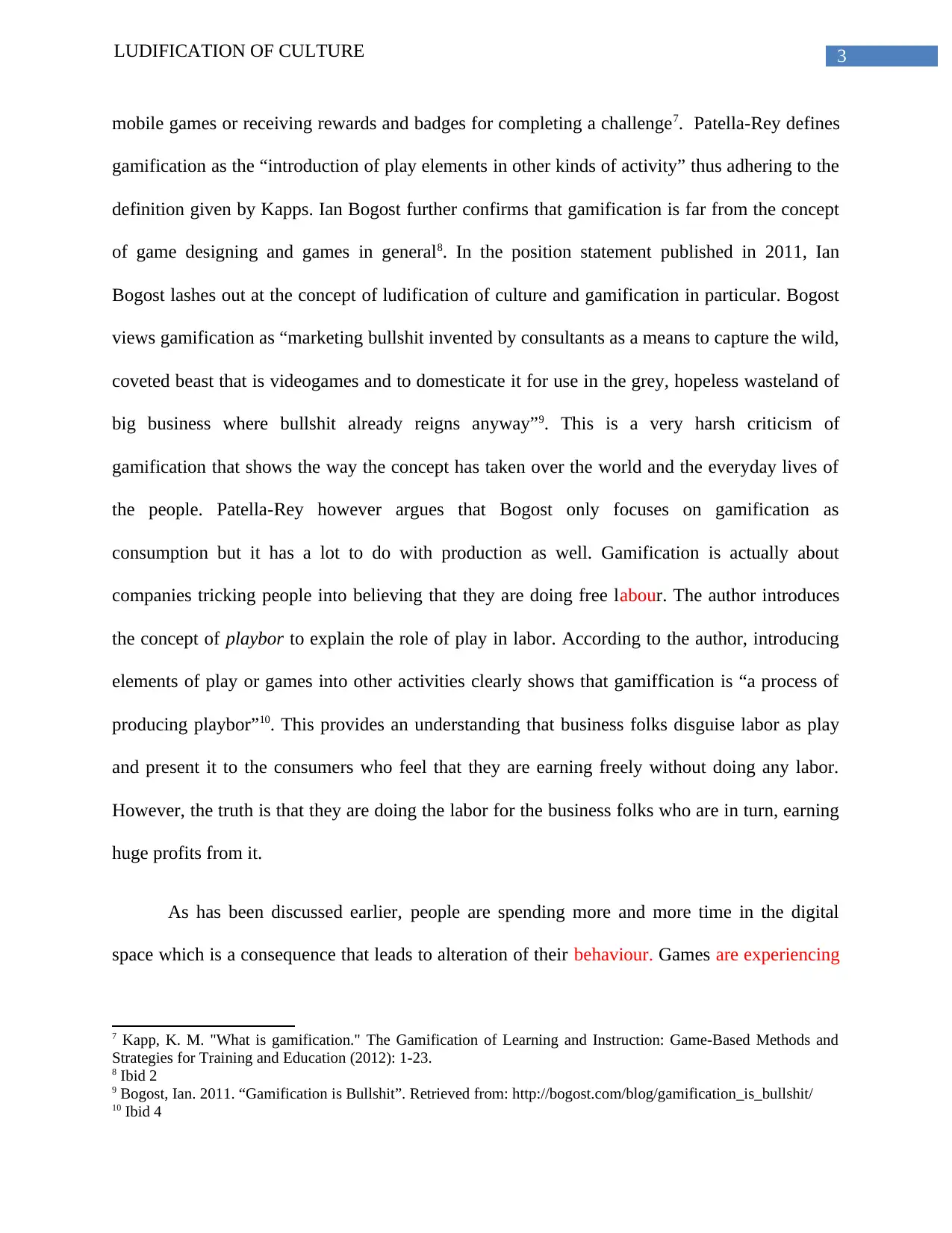
3LUDIFICATION OF CULTURE
mobile games or receiving rewards and badges for completing a challenge7. Patella-Rey defines
gamification as the “introduction of play elements in other kinds of activity” thus adhering to the
definition given by Kapps. Ian Bogost further confirms that gamification is far from the concept
of game designing and games in general8. In the position statement published in 2011, Ian
Bogost lashes out at the concept of ludification of culture and gamification in particular. Bogost
views gamification as “marketing bullshit invented by consultants as a means to capture the wild,
coveted beast that is videogames and to domesticate it for use in the grey, hopeless wasteland of
big business where bullshit already reigns anyway”9. This is a very harsh criticism of
gamification that shows the way the concept has taken over the world and the everyday lives of
the people. Patella-Rey however argues that Bogost only focuses on gamification as
consumption but it has a lot to do with production as well. Gamification is actually about
companies tricking people into believing that they are doing free labour. The author introduces
the concept of playbor to explain the role of play in labor. According to the author, introducing
elements of play or games into other activities clearly shows that gamiffication is “a process of
producing playbor”10. This provides an understanding that business folks disguise labor as play
and present it to the consumers who feel that they are earning freely without doing any labor.
However, the truth is that they are doing the labor for the business folks who are in turn, earning
huge profits from it.
As has been discussed earlier, people are spending more and more time in the digital
space which is a consequence that leads to alteration of their behaviour. Games are experiencing
7 Kapp, K. M. "What is gamification." The Gamification of Learning and Instruction: Game-Based Methods and
Strategies for Training and Education (2012): 1-23.
8 Ibid 2
9 Bogost, Ian. 2011. “Gamification is Bullshit”. Retrieved from: http://bogost.com/blog/gamification_is_bullshit/
10 Ibid 4
mobile games or receiving rewards and badges for completing a challenge7. Patella-Rey defines
gamification as the “introduction of play elements in other kinds of activity” thus adhering to the
definition given by Kapps. Ian Bogost further confirms that gamification is far from the concept
of game designing and games in general8. In the position statement published in 2011, Ian
Bogost lashes out at the concept of ludification of culture and gamification in particular. Bogost
views gamification as “marketing bullshit invented by consultants as a means to capture the wild,
coveted beast that is videogames and to domesticate it for use in the grey, hopeless wasteland of
big business where bullshit already reigns anyway”9. This is a very harsh criticism of
gamification that shows the way the concept has taken over the world and the everyday lives of
the people. Patella-Rey however argues that Bogost only focuses on gamification as
consumption but it has a lot to do with production as well. Gamification is actually about
companies tricking people into believing that they are doing free labour. The author introduces
the concept of playbor to explain the role of play in labor. According to the author, introducing
elements of play or games into other activities clearly shows that gamiffication is “a process of
producing playbor”10. This provides an understanding that business folks disguise labor as play
and present it to the consumers who feel that they are earning freely without doing any labor.
However, the truth is that they are doing the labor for the business folks who are in turn, earning
huge profits from it.
As has been discussed earlier, people are spending more and more time in the digital
space which is a consequence that leads to alteration of their behaviour. Games are experiencing
7 Kapp, K. M. "What is gamification." The Gamification of Learning and Instruction: Game-Based Methods and
Strategies for Training and Education (2012): 1-23.
8 Ibid 2
9 Bogost, Ian. 2011. “Gamification is Bullshit”. Retrieved from: http://bogost.com/blog/gamification_is_bullshit/
10 Ibid 4
Paraphrase This Document
Need a fresh take? Get an instant paraphrase of this document with our AI Paraphraser
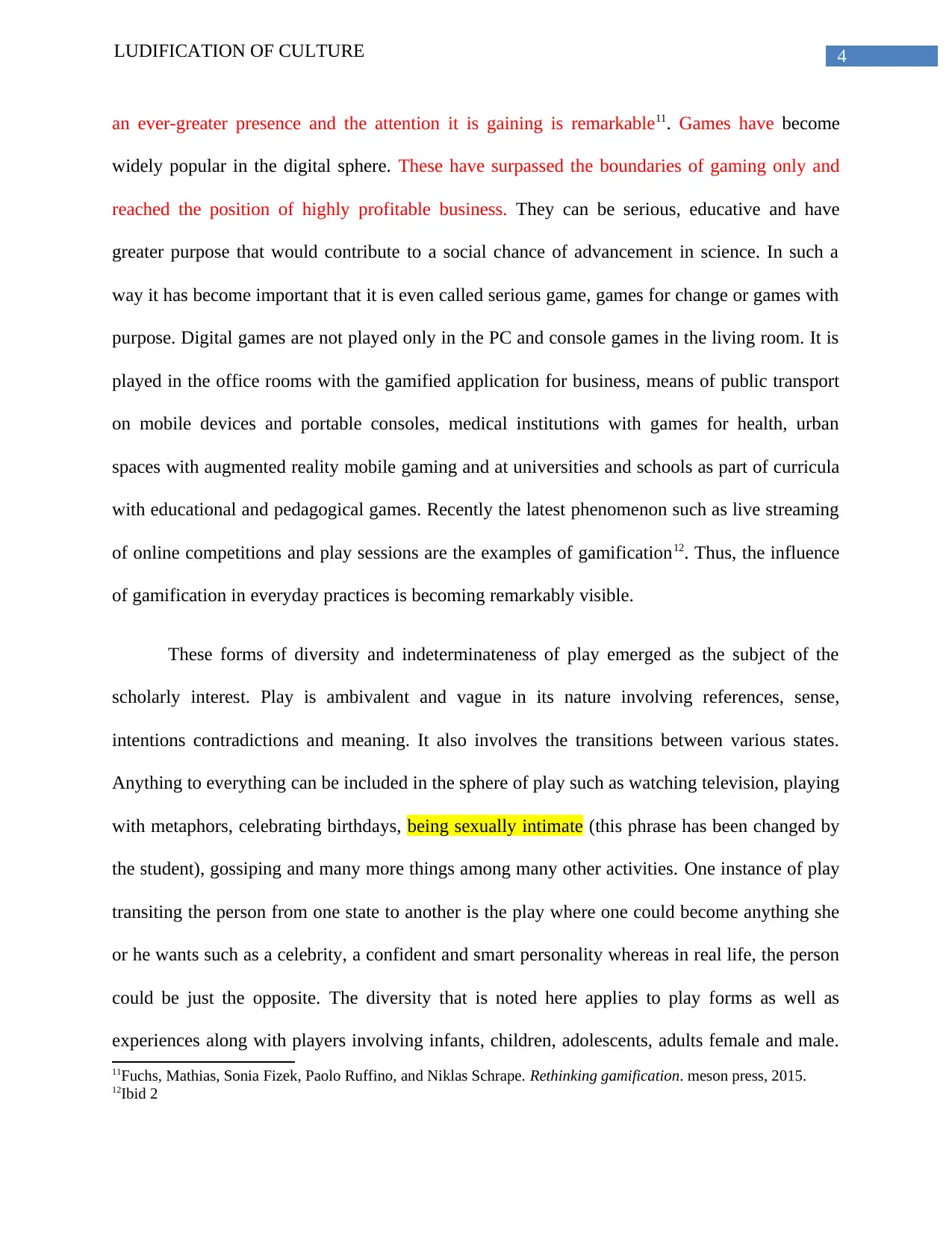
4LUDIFICATION OF CULTURE
an ever-greater presence and the attention it is gaining is remarkable11. Games have become
widely popular in the digital sphere. These have surpassed the boundaries of gaming only and
reached the position of highly profitable business. They can be serious, educative and have
greater purpose that would contribute to a social chance of advancement in science. In such a
way it has become important that it is even called serious game, games for change or games with
purpose. Digital games are not played only in the PC and console games in the living room. It is
played in the office rooms with the gamified application for business, means of public transport
on mobile devices and portable consoles, medical institutions with games for health, urban
spaces with augmented reality mobile gaming and at universities and schools as part of curricula
with educational and pedagogical games. Recently the latest phenomenon such as live streaming
of online competitions and play sessions are the examples of gamification12. Thus, the influence
of gamification in everyday practices is becoming remarkably visible.
These forms of diversity and indeterminateness of play emerged as the subject of the
scholarly interest. Play is ambivalent and vague in its nature involving references, sense,
intentions contradictions and meaning. It also involves the transitions between various states.
Anything to everything can be included in the sphere of play such as watching television, playing
with metaphors, celebrating birthdays, being sexually intimate (this phrase has been changed by
the student), gossiping and many more things among many other activities. One instance of play
transiting the person from one state to another is the play where one could become anything she
or he wants such as a celebrity, a confident and smart personality whereas in real life, the person
could be just the opposite. The diversity that is noted here applies to play forms as well as
experiences along with players involving infants, children, adolescents, adults female and male.
11Fuchs, Mathias, Sonia Fizek, Paolo Ruffino, and Niklas Schrape. Rethinking gamification. meson press, 2015.
12Ibid 2
an ever-greater presence and the attention it is gaining is remarkable11. Games have become
widely popular in the digital sphere. These have surpassed the boundaries of gaming only and
reached the position of highly profitable business. They can be serious, educative and have
greater purpose that would contribute to a social chance of advancement in science. In such a
way it has become important that it is even called serious game, games for change or games with
purpose. Digital games are not played only in the PC and console games in the living room. It is
played in the office rooms with the gamified application for business, means of public transport
on mobile devices and portable consoles, medical institutions with games for health, urban
spaces with augmented reality mobile gaming and at universities and schools as part of curricula
with educational and pedagogical games. Recently the latest phenomenon such as live streaming
of online competitions and play sessions are the examples of gamification12. Thus, the influence
of gamification in everyday practices is becoming remarkably visible.
These forms of diversity and indeterminateness of play emerged as the subject of the
scholarly interest. Play is ambivalent and vague in its nature involving references, sense,
intentions contradictions and meaning. It also involves the transitions between various states.
Anything to everything can be included in the sphere of play such as watching television, playing
with metaphors, celebrating birthdays, being sexually intimate (this phrase has been changed by
the student), gossiping and many more things among many other activities. One instance of play
transiting the person from one state to another is the play where one could become anything she
or he wants such as a celebrity, a confident and smart personality whereas in real life, the person
could be just the opposite. The diversity that is noted here applies to play forms as well as
experiences along with players involving infants, children, adolescents, adults female and male.
11Fuchs, Mathias, Sonia Fizek, Paolo Ruffino, and Niklas Schrape. Rethinking gamification. meson press, 2015.
12Ibid 2
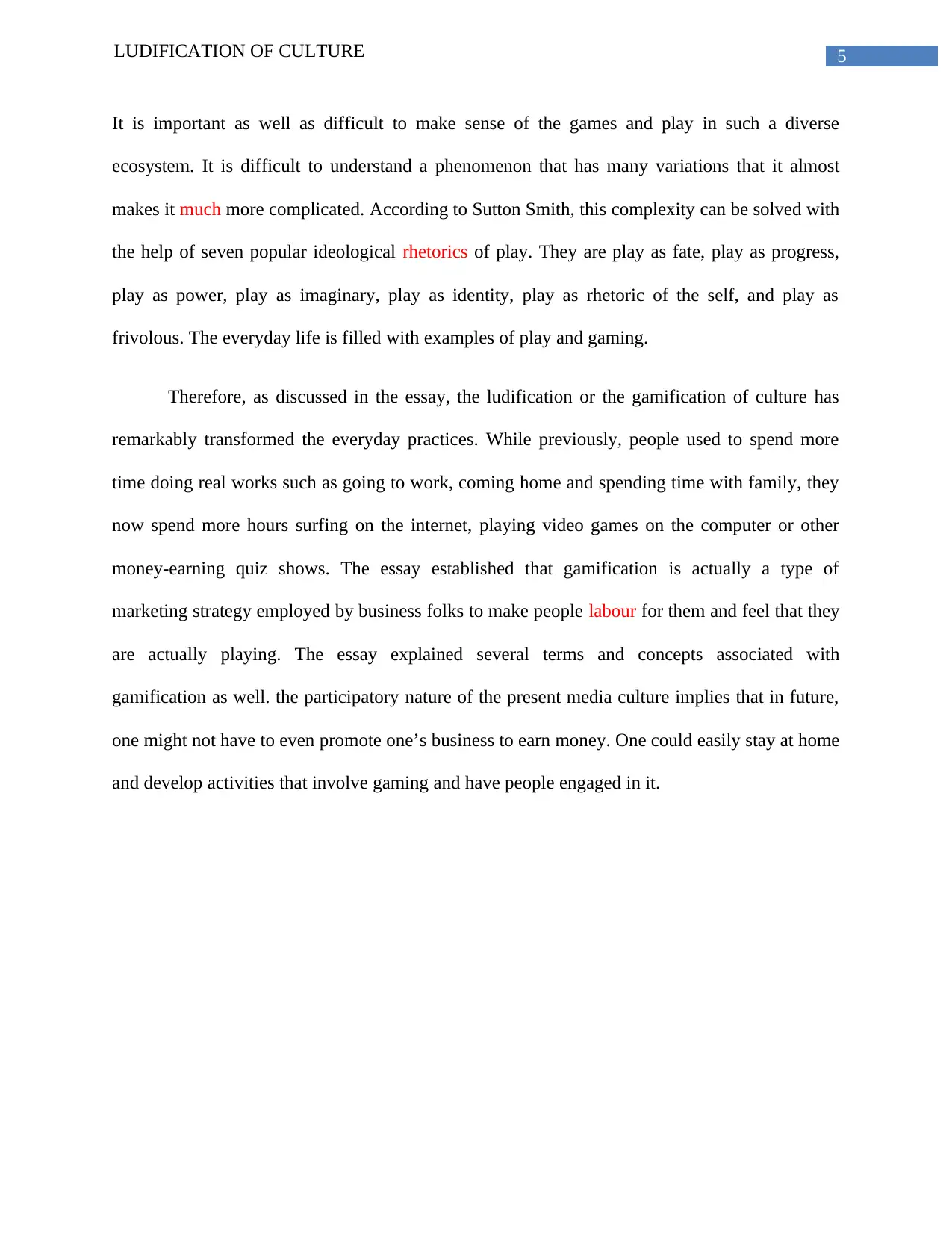
5LUDIFICATION OF CULTURE
It is important as well as difficult to make sense of the games and play in such a diverse
ecosystem. It is difficult to understand a phenomenon that has many variations that it almost
makes it much more complicated. According to Sutton Smith, this complexity can be solved with
the help of seven popular ideological rhetorics of play. They are play as fate, play as progress,
play as power, play as imaginary, play as identity, play as rhetoric of the self, and play as
frivolous. The everyday life is filled with examples of play and gaming.
Therefore, as discussed in the essay, the ludification or the gamification of culture has
remarkably transformed the everyday practices. While previously, people used to spend more
time doing real works such as going to work, coming home and spending time with family, they
now spend more hours surfing on the internet, playing video games on the computer or other
money-earning quiz shows. The essay established that gamification is actually a type of
marketing strategy employed by business folks to make people labour for them and feel that they
are actually playing. The essay explained several terms and concepts associated with
gamification as well. the participatory nature of the present media culture implies that in future,
one might not have to even promote one’s business to earn money. One could easily stay at home
and develop activities that involve gaming and have people engaged in it.
It is important as well as difficult to make sense of the games and play in such a diverse
ecosystem. It is difficult to understand a phenomenon that has many variations that it almost
makes it much more complicated. According to Sutton Smith, this complexity can be solved with
the help of seven popular ideological rhetorics of play. They are play as fate, play as progress,
play as power, play as imaginary, play as identity, play as rhetoric of the self, and play as
frivolous. The everyday life is filled with examples of play and gaming.
Therefore, as discussed in the essay, the ludification or the gamification of culture has
remarkably transformed the everyday practices. While previously, people used to spend more
time doing real works such as going to work, coming home and spending time with family, they
now spend more hours surfing on the internet, playing video games on the computer or other
money-earning quiz shows. The essay established that gamification is actually a type of
marketing strategy employed by business folks to make people labour for them and feel that they
are actually playing. The essay explained several terms and concepts associated with
gamification as well. the participatory nature of the present media culture implies that in future,
one might not have to even promote one’s business to earn money. One could easily stay at home
and develop activities that involve gaming and have people engaged in it.
⊘ This is a preview!⊘
Do you want full access?
Subscribe today to unlock all pages.

Trusted by 1+ million students worldwide
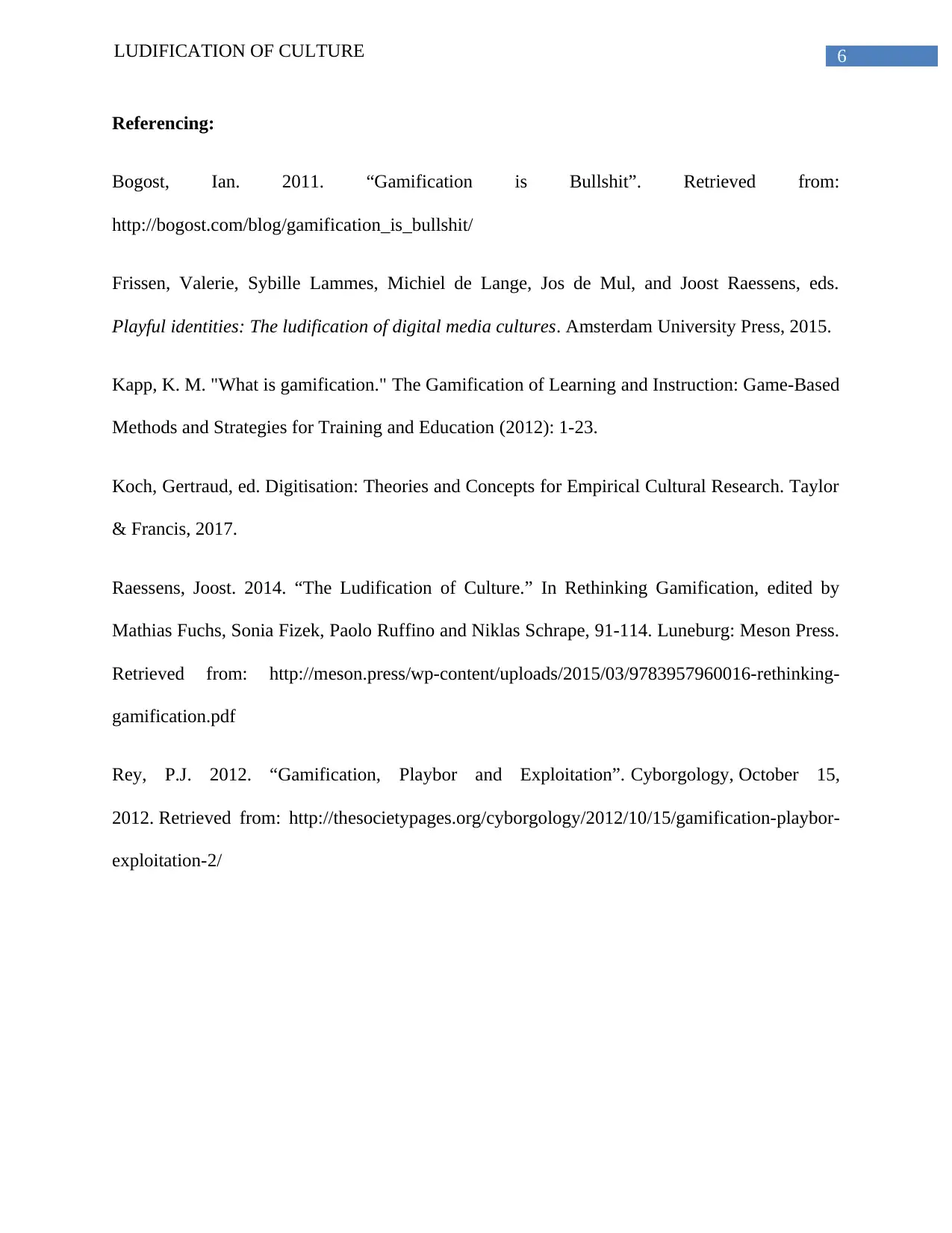
6LUDIFICATION OF CULTURE
Referencing:
Bogost, Ian. 2011. “Gamification is Bullshit”. Retrieved from:
http://bogost.com/blog/gamification_is_bullshit/
Frissen, Valerie, Sybille Lammes, Michiel de Lange, Jos de Mul, and Joost Raessens, eds.
Playful identities: The ludification of digital media cultures. Amsterdam University Press, 2015.
Kapp, K. M. "What is gamification." The Gamification of Learning and Instruction: Game-Based
Methods and Strategies for Training and Education (2012): 1-23.
Koch, Gertraud, ed. Digitisation: Theories and Concepts for Empirical Cultural Research. Taylor
& Francis, 2017.
Raessens, Joost. 2014. “The Ludification of Culture.” In Rethinking Gamification, edited by
Mathias Fuchs, Sonia Fizek, Paolo Ruffino and Niklas Schrape, 91-114. Luneburg: Meson Press.
Retrieved from: http://meson.press/wp-content/uploads/2015/03/9783957960016-rethinking-
gamification.pdf
Rey, P.J. 2012. “Gamification, Playbor and Exploitation”. Cyborgology, October 15,
2012. Retrieved from: http://thesocietypages.org/cyborgology/2012/10/15/gamification-playbor-
exploitation-2/
Referencing:
Bogost, Ian. 2011. “Gamification is Bullshit”. Retrieved from:
http://bogost.com/blog/gamification_is_bullshit/
Frissen, Valerie, Sybille Lammes, Michiel de Lange, Jos de Mul, and Joost Raessens, eds.
Playful identities: The ludification of digital media cultures. Amsterdam University Press, 2015.
Kapp, K. M. "What is gamification." The Gamification of Learning and Instruction: Game-Based
Methods and Strategies for Training and Education (2012): 1-23.
Koch, Gertraud, ed. Digitisation: Theories and Concepts for Empirical Cultural Research. Taylor
& Francis, 2017.
Raessens, Joost. 2014. “The Ludification of Culture.” In Rethinking Gamification, edited by
Mathias Fuchs, Sonia Fizek, Paolo Ruffino and Niklas Schrape, 91-114. Luneburg: Meson Press.
Retrieved from: http://meson.press/wp-content/uploads/2015/03/9783957960016-rethinking-
gamification.pdf
Rey, P.J. 2012. “Gamification, Playbor and Exploitation”. Cyborgology, October 15,
2012. Retrieved from: http://thesocietypages.org/cyborgology/2012/10/15/gamification-playbor-
exploitation-2/
1 out of 7
Your All-in-One AI-Powered Toolkit for Academic Success.
+13062052269
info@desklib.com
Available 24*7 on WhatsApp / Email
![[object Object]](/_next/static/media/star-bottom.7253800d.svg)
Unlock your academic potential
Copyright © 2020–2025 A2Z Services. All Rights Reserved. Developed and managed by ZUCOL.
